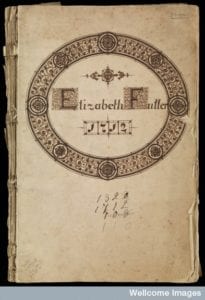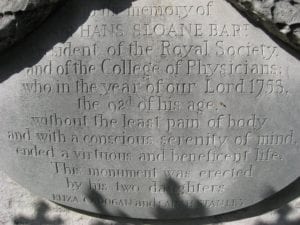By James Hawkes
Sir Hans Sloane is a man who is justly remembered for many things, as a philanthropist, President of the Royal Society, and father of the British Museum. But one thing it seems he shall always be remembered for is inventing milk chocolate. For that alone he would truly deserve to be remembered as one of the greatest luminaries of his own or any other age. But…
Does Sloane deserve to be credited as the inventor of milk chocolate as he is so often lauded for all across the internet? Even the British Museum proclaims that “It was Sir Hans Sloane who introduced milk chocolate for drinking.” Unfortunately it seems that Sloane and milk chocolate is a myth with little basis in reality.
Chocolate had been in use long before Columbus, with the Mesoamericans drinking a bitter but spicy chocolate drink. Following the Spanish conquest similar chocolate drinks spread to Spain and gradually began to slowly make inroads throughout Europe. It was not until shortly before Sloane’s birth in the mid-seventeenth century that chocolate began to enter the English consciousness as both a medicine and an exotic treat for the English elite. Sloane’s life witnessed an increasing prevalence of chocolate in England, although it remained a luxury. Its status as a luxury good and status symbol is underscored by the beautiful chocolate cups Sloane imported from Italy. Chocolate was thought to have many different properties, it could serve as an aphrodisiac or help with hangovers.
But contrary to popular belief Sloane did not invent the concept of milk chocolate. In fact, a great variety of milk chocolates and even icy chocolate cream recipes had been published for the English market in the seventeenth century.[1] Shortly after Sloane’s death in 1753 an entrepreneur named Nicholas Sanders brought Sloane’s Milk Chocolate onto the market. Sanders claimed to have an original chocolate recipe from Sloane as he battled against others attempting to purvey chocolate with Sloane’s name.[2] Sloane’s name remained golden, so far as chocolate buyers were concerned. The famous Cadbury Company even sold chocolate under his name in the nineteenth century. And of course, there is the modern Hans Sloane Drinking Chocolate.
As James Delbourgo has argued, Sloane–a rich baronet–would have had little motivation to get into such a grubby business as chocolate selling. Particularly “in an era that prized the public fiction of gentlemanly disinterestedness,” a close association with an item which had such negative, even racy connotations, would not have served his hard won image of virtue.[3] Sloane was a doctor and as such had been known to prescribe chocolate medicinally now and again. He even appears to have enjoyed it as a treat on occasion.
Sloane’s time in Jamaica had given him first-hand experience of the exotic, including the use of cocoa. His scientific publications included high quality illustrations of cocoa and he preserved a botanical specimen in his collection.
Chocolate suffered a bit of a branding problem in England since first entering the market in the seventeenth century. Promoters often attempted to improve its reputation by claiming that their recipes had sanction from the high and mighty, whether a king, or like Sloane–a famed physician to royalty.
In the eighteenth century, the lower classes were unlikely to consume chocolate, while chocolate took on decadent, even subversive associations in elite culture. Chocolate houses often catered to gambling (such as the famous modern gentlemen’s club White’s which was founded as a chocolate house) and on the political spectrum it included the almost-Jacobite Ozinda’s, with the Cocoa Tree serving as an unofficial Tory headquarters.

White’s Chocolate House, London c.1708 coloured lithograph published by Cadbury. Image Source: Wikimedia Commons.
So why does the idea that Sloane invented milk chocolate persist? Well, it makes a nice story and, once a story becomes common, it can be difficult to correct. It is an easy and compelling tale to have the first inventor of something be a famous and important person who got it right the first time… Unfortunately the attribution of milk chocolate to Sloane is no more than just another tasty myth.
[1] Kate Loveman, “The Introduction of Chocolate into England: Retailers, Researchers, and Consumers, 1640-1730,” Journal of Social History, No. 47 Vol. 1 (2013): 34-35.
[2] James Delourgo, “Sir Hans Sloane’s Milk Chocolate and the Whole History of the Cacao,” Social Text 106, Vol. 29, No. 1 (2011): 86.
[3] Ibid.


![A woman is carrying a tray with a cup of chocolate [or maybe the pleurisy remedy?] and a glass on it. Credit: Wellcome Library, London.](http://sloaneletters.com/wp-content/uploads/2014/01/Cup-of-chocolate-221x300.jpg)





